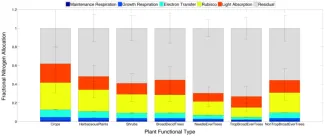A Global Trait-Based Approach to Estimate Leaf Nitrogen Functional Allocations from Observations
We developed here a comprehensive global analysis of nitrogen allocation in leaves for major processes with respect to different plant functional types. Based on our analysis, crops partition the largest fraction of nitrogen to photosynthesis and respiration. Tropical broadleaf evergreen trees partition the least to photosynthesis and respiration. In trees (especially needle-leaved evergreen and tropical broadleaf evergreen trees) a large fraction of nitrogen was not explained by photosynthetic or respiratory functions. Compared to crops and herbaceous plants, this large residual pool is hypothesized to emerge from larger investments in cell wall proteins, lipids, amino acids, nucleic acid, CO2 fixation proteins (other than Rubisco), secondary compounds, and other proteins. The resulting pattern of nitrogen allocation provides insights on mechanisms that operate at a cellular scale within leaves, and can be integrated with ecosystem models to derive emergent properties of ecosystem productivity at local, regional, and global scales.
Nitrogen is one of the most important nutrients for plant growth and a major constituent of proteins that regulate photosynthetic and respiratory processes. This study integrated observations from global databases with photosynthesis and respiration models to determine plant-functional-type-specific allocation patterns of leaf nitrogen for photosynthesis and respiration.
Our observationally-constrained nitrogen allocation estimates provide insights on mechanisms that operate at a cellular scale within leaves, and can be integrated with ecosystem models to derive emergent properties of ecosystem productivity at local, regional, and global scales.
Ghimire, B., WJ Riley, CD Koven, J Kattge, A Rogers, PB Reich, and IJ Wright. 2017. A global trait‐based approach to estimate leaf nitrogen functional allocation from observations. Ecological Applications, 27:1421-1434. https://doi.org/10.1002/eap.1542
This research was supported by the Director, Office of Science, Office of Biological and Environmental Research of the US Department of Energy under Contract No. DE-AC02-05CH11231 as part of the Next-Generation Ecosystem Experiments (NGEE Arctic) project. The study has been supported by the TRY initiative on plant traits (http://www.try-db.org), which is/has been supported by DIVERSITAS, IGBP, the Global Land Project, the UK Natural Environment Research Council (NERC) through its program QUEST (Quantifying and Understanding the Earth System), the French Foundation for Biodiversity Research (FRB), and GIS "Climat, Environnement et Société" France.”
For more information, please contact:
William Riley
wjriley@lbl.gov

